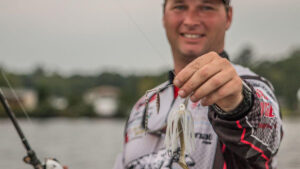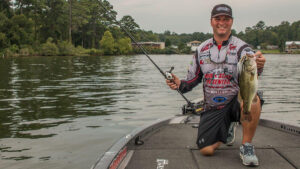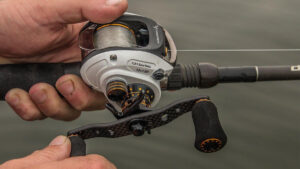Whether our thermometers are reflecting it or not, a major seasonal transition is quickly heading our direction. The days are becoming shorter, the nights are cooling and unfortunately, the bass fishing is about to get downright funky. While this awkward “in-between†period may cause many outdoorsmen to trade their rods and reels for bows and arrows, steadfast anglers have a unique opportunity to utilize an age-old lure that’s often overlooked.
According to FLW Tour pro Clayton Batts, spinnerbaits are an excellent way to combat the tough fishing of the fall transition period. As both the bass and shad begin making their treks from deep summertime haunts, these lures possess an intriguing ability to cover multiple depth ranges with maximum efficiency.
Before you let the Jekyll and Hyde-type nature of this annual phenomenon get in your head, Batts believes there are several factors that can drastically improve your success.
10 feet or deeper
Water temperature: Upper 80 to 90-degree range
When the bass are just beginning to “wake up†from their summertime lull, they’ll start slowly making their way towards the mouths of major creeks. The shad migration might not be in full-swing yet, but they know it’s coming. This is when Batts suggests using a heavy spinnerbait to target the bass that are basically waiting for the action to start.
“If the fish are still fairly deep, I rely on a 1 or 1 1/4-ounce spinnerbait, such as the Strikezone Ledgebuster,†Batts said. “It’s my go-to bait before things really get cranked up. Creek channels become a big deal because they’re going to be the first natural stopping point for bass coming out of the main river channel. I’m looking for the first irregularity in the channel such as an outside bend or even some deeper brush piles or stumps.â€
Although they’re not always included in the discussion of deep-water bass fishing lures, don’t be afraid to use these heavy spinnerbaits in depths up to 25 feet. In situations when many will opt for a 1-ounce swimbait, Batts relies on his spinnerbait due to its snag-resistant nature.
6 to 10 feet
Water temperature: Low to middle 80-degree range
This is when things can really start happening for the autumn bass angler—the shad have arrived, the bass are waiting on them and the feeding frenzy will commence any day. To better accommodate the shallower depths, Batts downsizes his spinnerbait to a 1/2-ounce Strikezone Master Blaster.
“This particular spinnerbait has a hidden weight, which maintains an effective weight while also allowing it to have a smaller, more subtle profile,†Batts said. “At this point in the transition, I’m going to begin targeting the shallower ditches that run all the way to the backs of creeks. I’ve found that creeks with smaller feeder creeks in the very back of them are the best places to find these ditches. You’ll have the most success by putting your boat in the middle of the ditch and making 45-degree casts to the shallows and bringing your spinnerbait off the lip of the ditch.â€
It’s important to remember that bass are ambush feeders, which makes these ditch edges particularly appealing. They’re able to lurk in the deeper depths while keeping a close watch for any unfortunate shad swimming overhead.

2 to 6 feet
Water temperature: Middle 70 to 80-degree range
If you’re a confident shallow-water angler, this stage of the transition is when you’re in your ultimate comfort zone. The bass and the shad will become a bit more widely spread, meaning your “junk fishing†skills will come in handy.
“Any isolated cover is absolutely key right now,†Batts said. “You can cast to the visible balls of shad in the middle of these creeks, but you’ll most likely end up catching a bunch of small schoolers. The larger fish are loners—they don’t want competition—so you’ll want to carefully dissect docks, stumps and shallow, irregular grass lines close to the bank. Make repeated casts to these strategic ambush points because they’re certainly high-percentage areas.â€
Batts suggests using a versatile 3/8-ounce spinnerbait, such as a Strikezone Edgebuster. It’s heavy enough to collide with deeper stumps and brush piles, yet lightweight enough to wake just beneath the surface around dock posts and grass lines.
2 feet or less
Water temperature: High 60 to middle 70-degree range
When the water temperature hits this range, stealth becomes a key component in Batts’ strategy. A well-placed cast can prove fruitless if your spinnerbait is too heavy.
“At this point, the shad are as far back in the creeks as they can go,†Batts said. “The bass have ‘em herded into small, easy-to-predict areas, but you have to use a subtle spinnerbait. I use a 1/4-ounce Strikezone Edgebuster because if you use one much heavier, it’s going to sound like a basketball landing in the shallow water and will totally spook the fish. A smaller spinnerbait will also increase your efficiency because you won’t be scraping the leaves and pine straw off the bottom.â€
Although Batts uses willow leaf blades for the large majority of his fishing during the fall transition, he’ll often switch to Colorado blades in this situation. Remember, the backs of these creeks are more prone to heavy runoff and muddy water, so the increased vibration and water displacement of a larger blade will allow the bass to easily find your spinnerbait with its lateral line.
Quick spinnerbait tweaks worth noting
Like most bass anglers, Batts rarely fishes with a lure out of the package without some sort of performance-enhancing modification. Here are 4 that can drastically improve your catch throughout the fall transition.
1. Trailer hook
Perhaps the most obvious of his spinnerbait tweaks, that shouldn’t discount its effectiveness. Except for fishing deep brush piles, Batts uses a trailer hook—a Gamakatsu SP—religiously. Fall bass will often initially swat at a group of baitfish in order to stun or kill them, so a sharp trailer hook gives him a bit more insurance when money is on the line.
2. Blade size
“If you’re using a 3/8-ounce spinnerbait and noticing a bunch of large shad in the back of a particular creek, upsizing that No. 4 1/2 back blade to a No. 7 1/2 blade can make all the difference in the world,†Batts said. “It can give it a bit more action, but more importantly, it matches the size of the bait on which they’re feeding. Don’t discount blade size throughout this transition.â€
3. Smoke ‘em out
If you frequent clear water, you might want to bring a black Sharpie along for the ride. Although live shad do flash and shimmer, the “loud†flash of spinnerbait blades can be a bit overpowering and unnatural to the bass in high-visibility scenarios. Batts will give his blades a very light and impromptu paint job with a black permanent marker to mute the flash of the blades a bit.
4. Soft-plastic trailers
When you find the mother lode of shad, you can certainly catch a few bass on a spinnerbait without a trailer, but Batts finds the addition of a soft-plastic trailer bulks up the profile and results in bigger bass.
“On my deeper spinnerbaits, I’ll use some type of smaller swimbait trailer such as a Strike Zone Zombie Shad or Big Bite Baits Cane Thumper,†Batts said. “When I’m using smaller, more subtle swimbaits, I have a lot of success with a Big Bite Baits Finesse Grub.â€
Gear and retrieve considerations
We’ve all caught a few fish following a haphazard cast and an aimless retrieve, but you’ll enjoy much more consistent success when you pay close attention to your retrieve speed. Batts uses particular gear ratios to his advantage when spinnerbait fishing.
1/2-ounce to 1 1/4-ounce
“When I’m trying to keep my spinnerbait close to the bottom in deeper depths, I make sure to use a 6.3:1 gear ratio casting reel, such as the Ardent Apex Grand,†Batts said. “I love to fish fast, so I really have to make myself slow down in order to keep the lure within a foot of the bottom.â€
To maximize his spinnerbaits’ time in the optimal strike zone, he uses a 7-foot, 2-inch medium-heavy Denali Kovert. A longer rod allows for long casts and more time in the “juiceâ€.
1/4-ounce to 3/8-ounce
“Anytime you’re fishing a small spinnerbait around shallow flats and cover throughout the transition, a lot of your bites are going to occur within the first few cranks of the reel handle,†Batts said. “I want the ability to eat up a lot of line quickly, so I’ll actually use a 7.1:1 Ardent Apex Grand. The shallower I’m fishing, the more erratic I want my presentation, so I’ll pop my rod tip pretty aggressively between every other handle turn. Also, you’ll have an easier time using a shorter rod when you’re back in skinny water, so that’s why I use a 6-foot, 9-inch medium-heavy Denali Kovert.â€
If you can get your mind off of college football and hunting season, make an effort to spend a few afternoons on the lake. It might take you a while to find those finicky transition bass, but when you do—it’ll be totally worth it.














